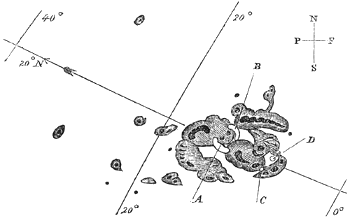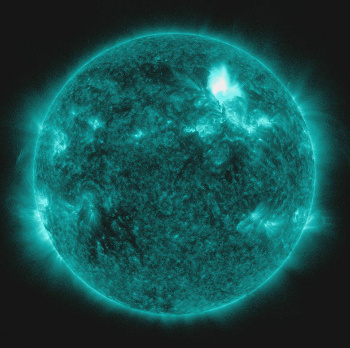Space Weather
May 23, 2012
Quite a few of us have visited
The Weather Channel web site,
weather.com. In the early days of
domain name acquisitions, this name was surely a prime plum. Few of us have visited another weather page,
spaceweather.com.
Weather in space is a strange idea, since the
usual definition of weather is "the state of the atmosphere with respect to heat or cold, wetness or dryness, calm or storm, clearness or cloudiness," and there's no
atmosphere in
space.
Space weather extends the definition from "atmosphere" to "environment," and it looks at conditions such as
radiation,
magnetic fields, and
solar plasma. Quite naturally, our
Sun controls the weather in our
solar system, and a common bellwether for space weather is
sunspot number. An active sun has many spots.

Sunspots on September 1, 1859, as drawn by English astronomer, Richard Carrington
(Via Wikimedia Commons))
There is some correlation between space weather and
terrestrial weather. The
Little Ice Age happened at the same time as the
Maunder Minimum, a marked deficit of sunspots from 1650-1700. A similar effect was noted at the less dramatic
Spörer Minimum between 1460 and 1550. Since there are many factors that determine
Earth's temperature, a causal connection here is not established.
Causality notwithstanding,
William Stanley Jevons, a
British economist, proposed that there's a correlation between sunspots and
business cycles. Jevons reasoning was that, if sunspots affect terrestrial weather, they would affect
agricultural output.[1] This doesn't appear to be the reason why
financial companies employ
physicists.
Some will even lump
asteroids into space weather, with a
meteor shower possibly as an analogy to a
hailstorm. I wrote about the threat of
meteor impact and possible mitigation technologies in a
recent article (Asteroid Deflection, April 19, 2012).
Although the impact of a large meteor will affect our civilization dramatically, how much of the rest of space weather is really important?
Satellites, which are outside the protection of Earth's atmosphere and magnetic field, are especially vulnerable, but the affect of space weather on
technology goes back farther than the last few decades. Space weather was first felt on Earth when we started stringing long lengths of wire around the planet.
Solar flares, the sudden eruption of matter from a patch of the Sun, involve a considerable amount of
energy, about 6 x 10
25 joules. The instantaneous (at least by
light speed) affect of these is an enhanced flux of
X-rays and
ultraviolet radiation on the Earth that disrupts our
ionosphere and
radio communications that rely on the ionosphere to bounce signals around the Earth.
A while after the
electromagnetic waves, there's actual matter from the Sun that reaches the Earth. This is a stream of
protons that affects the shape of Earth's
magnetosphere, but also increases
electric currents in the magnetosphere and ionosphere. Such
geomagnetic storms cause the
aurora borealis, in the
northern hemisphere, and
aurora australis, in the
southern hemisphere.
As
Michael Faraday demonstrated long ago in the principle of
electromagnetic induction, a changing magnetic field will produce an electrical current in a
conductor. The solar flare induced disruption of the Earth's magnetosphere will produce
geomagnetically induced currents in conductors on Earth.
Such currents were first noticed by
telegraph operators during an intense
solar storm in 1859. Many telegraph systems failed, since the large induced currents fused wires and equipment; and some telegraph operators received
electrical shocks.

An early Morse telegraph key. It's easy to see how an operator could receive a shock from one of these.
(Photograph by Hannes Grobe, via Wikimedia Commons))
Two and a half
centuries after the 1859 solar storm, we have much bigger problems. Instead of a few telegraph lines, we have a huge
electrical power grid, and many conductive underground
pipes. We don't expect the piping to melt, but electrical currents will induce
galvanic corrosion. A 1972 storm disrupted
long-distance telephone service in
Illinois.[2]
The vulnerability of the electrical grid was demonstrated when a severe geomagnetic storm on March 13, 1989, shut down the electrical system in
Québec, Canada, for nine hours, affecting six million people. The
economic impact of that event was estimated to be two billion
Canadian dollars.[3] Since that time, there's been a serious investment by
power companies to prevent such occurrences.
And it's good that they have, since the largest recorded solar flare of our time occurred on
November 4, 2003. This flare, at 1950
UT, was so intense that its radiation went above the upper operating limit of the
X-ray detectors on the
GOES satellites for eleven minutes. These detectors were designed to take measurements up to an intensity of 1.74
milliwatts/
square meter. The estimated maximum intensity of this flare was about 2.4 milliwatts/square meter.[4]

Solar flare of January 23, 2012, imaged at a wavelength of 13.1 nanometers by the Solar Dynamics Observatory.
The image time was 05:28:23 UT.
(NASA/SDO/AIA image))
This year, major solar flares have been frequent. There was one on
January 23, 2012 (see satellite image, above), and a more recent one in
March. The March flare was expected to cause considerable problems for satellites, but the majority of the
coronal mass ejection missed the Earth.[2]
One area of concern is the
Global Positioning System (GPS), which has engendered a positioning industry that's increasing in scope from $13 billion in 2003 to an estimated near $1 trillion by 2017.[5] The
Eastern US is especially vulnerable to space weather, since the power grid is dense and interconnected.
Daniel Baker, of the
University of Colorado's Laboratory for Atmospheric and Space Physics, is quoted by
National Geographic as saying,
"Imagine large cities without power for a week, a month, or a year... The losses could be $1 to $2 trillion, and the effects could be felt for years."[5]
Fortunately, the electromagnetic signals are an early warning for the particle streams that arrive about a day later. Power companies can temporarily break circuits at the warning of a severe storm, so there would be a blackout of just a few hours, and not days, or weeks, or worse.[5]
A recent study, published in the journal, Space Weather, modeled the occurrence of intense solar storms as a
power law.[6] The model predicts a solar storm of the magnitude of the 1859 event will occur with a 12%
probability in the next decade.[6] Time for me to search for sources of
tinfoil hats on the Internet.
References:
- Carlos Garcia-Mata and Felix I. Shaffner, "Solar and Economic Relationships:1 A Preliminary Report," The Quarterly Journal of Economics, vol. 49, no. 1 (November, 1934), pp. 1-51.
- Solar storm passes without incident, BBC News, March 8, 2012.
- Amina Khan, "Space weather expert has ominous forecast," Los Angeles Time, May 4, 2012.
- NASA SOHO - The "X-Whatever" Solar Flare, November 4, 2003, YouTube video.
- Richard A. Lovett, "Solar Flare: What If Biggest Known Sun Storm Hit Today?" National Geographic News, March 8, 2012.
- Pete Riley, "On the probability of occurrence of extreme space weather events," Space Weather, vol. 10, February 23, 2012, doi:10.1029/2011SW000734, 12 pages.
Permanent Link to this article
Linked Keywords: The Weather Channel; weather.com; domain name acquisition; spaceweather.com; Weather; weather definition; atmosphere; space; space weather; radiation; magnetic field; solar plasma; Sun; solar system; sunspot; Richard Carrington; Wikimedia Commons; terrestrial weather; Little Ice Age; Maunder Minimum; Spörer Minimum; Earth's temperature; William Stanley Jevons; British; economist; business cycle; agriculture; finance; financial; quantitative analyst; Quant; physicist; asteroid; meteor shower; hailstorm; meteor impact; satellite; technology; solar flare; energy; joule; speed of light; light speed; X-ray; ultraviolet; ionosphere; radio communications; electromagnetic wave; proton; magnetosphere; electric current; geomagnetic storm; aurora borealis; northern hemisphere; aurora australis; southern hemisphere; Michael Faraday; electromagnetic induction; electrical conductor; geomagnetically induced current; telegraph; solar storm in 1859; electrical shock; Morse telegraph key; Hannes Grobe; century; electrical power grid; pipe; galvanic corrosion; long-distance telephone service; Illinois; Québec, Canada; economy; economic; Canadian dollar; electric power industry; power company; solar flare, November 4, 2003; Universal Time; UT; X-ray detector; GOES satellites; milliwatt; square meter; solar flare of January 23, 2012; NASA/SDO/AIA; solar flare, January 23, 2012; March; coronal mass ejection; Global Positioning System; Eastern United States; Daniel Baker; University of Colorado; Laboratory for Atmospheric and Space Physics; National Geographic; power law; probability; tinfoil hat.